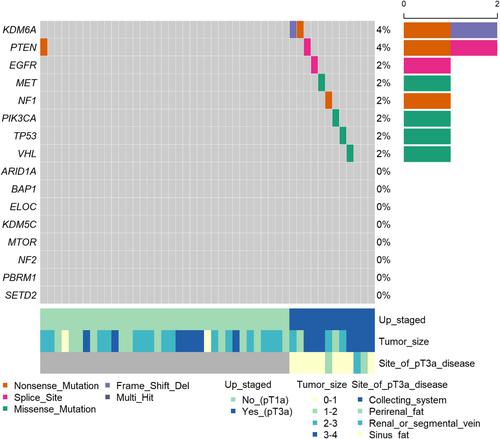当前位置:
X-MOL 学术
›
Cancer Sci.
›
论文详情
Our official English website, www.x-mol.net, welcomes your feedback! (Note: you will need to create a separate account there.)
ctDNA predicts clinical T1a to pathological T3a upstaging after partial nephrectomy
Cancer Science ( IF 5.7 ) Pub Date : 2024-03-13 , DOI: 10.1111/cas.16146 Jee Soo Park 1 , Hongkyung Kim 2 , Won Sik Jang 1 , Jongchan Kim 1, 3 , Won Sik Ham 1 , Seung‐Tae Lee 4, 5
Cancer Science ( IF 5.7 ) Pub Date : 2024-03-13 , DOI: 10.1111/cas.16146 Jee Soo Park 1 , Hongkyung Kim 2 , Won Sik Jang 1 , Jongchan Kim 1, 3 , Won Sik Ham 1 , Seung‐Tae Lee 4, 5
Affiliation

|
Most patients diagnosed with clear cell renal cell carcinoma (ccRCC) are also detected with small and organ‐confined tumors, and the majority of these are classified as clinical tumor stage 1a (cT1a). A considerable proportion of patients with cT1 RCC shows tumor upstaging to pathological stage 3a (pT3a), and these patients have worse oncological outcomes. The role of circulating tumor DNA (ctDNA) in RCC has been limited to monitoring treatment response and resistance. Therefore, the present study aimed to evaluate the potential of ctDNA in predicting pT3a upstaging in cT1a ccRCC. We sequenced plasma samples preoperatively collected from 48 patients who had undergone partial nephrectomy for cT1a ccRCC using data from a prospective cohort RCC. The ctDNA were profiled and compared with clinicopathological ccRCC features to predict pT3a upstaging. Associations between ctDNA, tumor complexity, and pT3a upstaging were evaluated. Tumor complexity was assessed using the anatomical classification system. Univariate analysis used chi‐squared and Student's t ‐tests; multivariate analysis considered significant factors from univariate analyses. Of the 48 patients with cT1a ccRCC, 12 (25%) were upstaged to pT3a, with ctDNA detected in 10 (20.8%), predominantly in patients with renal sinus fat invasion (SFI; n = 8). Among the pT3a group, ctDNA was detected in 75%, contrasting with only 2.8% in patients with pT1a (1/36). Detection of ctDNA was the only significant preoperative predictor of pT3a upstaging, especially in SFI. This study is the first to suggest ctDNA as a preoperative predictor of pT3a RCC upstaging from cT1a based on preoperative radiological images.
中文翻译:

ctDNA 预测肾部分切除术后临床 T1a 到病理 T3a 的升期
大多数诊断为透明细胞肾细胞癌 (ccRCC) 的患者也检测到小肿瘤和器官局限性肿瘤,其中大多数被归类为临床肿瘤 1a 期 (cT1a)。相当比例的cT1 RCC患者显示肿瘤升级至病理分期3a(pT3a),并且这些患者的肿瘤学结果较差。循环肿瘤 DNA (ctDNA) 在 RCC 中的作用仅限于监测治疗反应和耐药性。因此,本研究旨在评估 ctDNA 在预测 cT1a ccRCC 中 pT3a 升期的潜力。我们使用前瞻性队列 RCC 的数据对术前从 48 名因 cT1a ccRCC 接受部分肾切除术的患者收集的血浆样本进行了测序。对 ctDNA 进行分析并与临床病理学 ccRCC 特征进行比较,以预测 pT3a 分期。评估了 ctDNA、肿瘤复杂性和 pT3a 分期之间的关联。使用解剖分类系统评估肿瘤复杂性。单变量分析使用卡方和Student'st ‐测试;多变量分析考虑了单变量分析中的重要因素。在 48 例 cT1a ccRCC 患者中,12 例 (25%) 升级为 pT3a,其中 10 例 (20.8%) 检测到 ctDNA,主要发生在肾窦脂肪侵犯 (SFI;n = 8)。在 pT3a 组中,75% 的患者检测到 ctDNA,而 pT1a 患者中仅检测到 2.8% (1/36)。ctDNA 检测是 pT3a 升期的唯一重要术前预测因子,尤其是在 SFI 中。这项研究首次根据术前放射学图像提出 ctDNA 作为 pT3a RCC 分期从 cT1a 升级的术前预测因子。
更新日期:2024-03-13
中文翻译:

ctDNA 预测肾部分切除术后临床 T1a 到病理 T3a 的升期
大多数诊断为透明细胞肾细胞癌 (ccRCC) 的患者也检测到小肿瘤和器官局限性肿瘤,其中大多数被归类为临床肿瘤 1a 期 (cT1a)。相当比例的cT1 RCC患者显示肿瘤升级至病理分期3a(pT3a),并且这些患者的肿瘤学结果较差。循环肿瘤 DNA (ctDNA) 在 RCC 中的作用仅限于监测治疗反应和耐药性。因此,本研究旨在评估 ctDNA 在预测 cT1a ccRCC 中 pT3a 升期的潜力。我们使用前瞻性队列 RCC 的数据对术前从 48 名因 cT1a ccRCC 接受部分肾切除术的患者收集的血浆样本进行了测序。对 ctDNA 进行分析并与临床病理学 ccRCC 特征进行比较,以预测 pT3a 分期。评估了 ctDNA、肿瘤复杂性和 pT3a 分期之间的关联。使用解剖分类系统评估肿瘤复杂性。单变量分析使用卡方和Student's



























 京公网安备 11010802027423号
京公网安备 11010802027423号